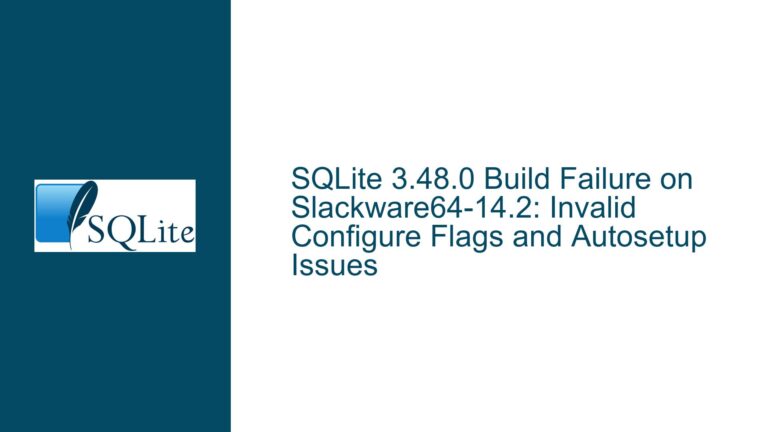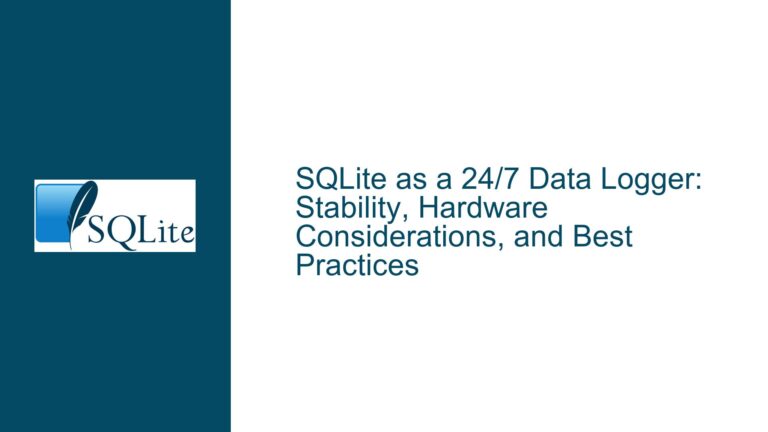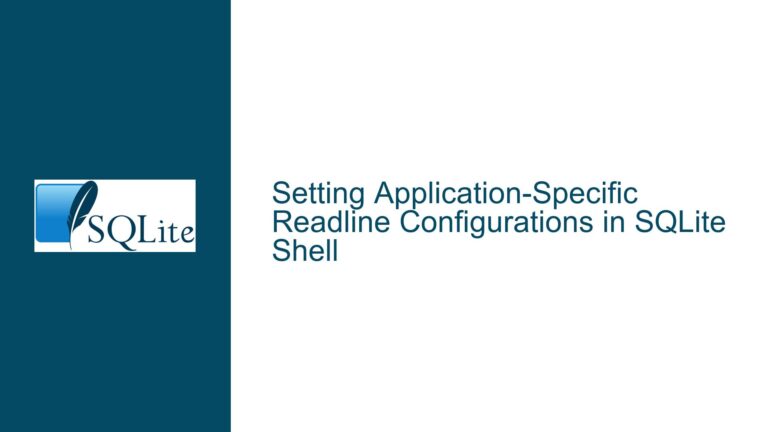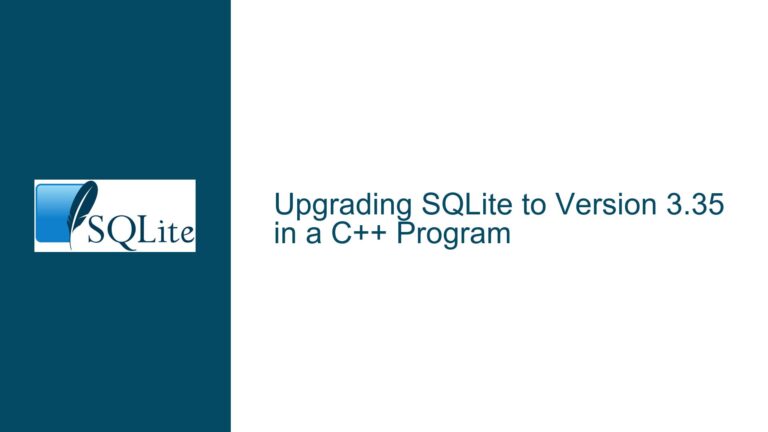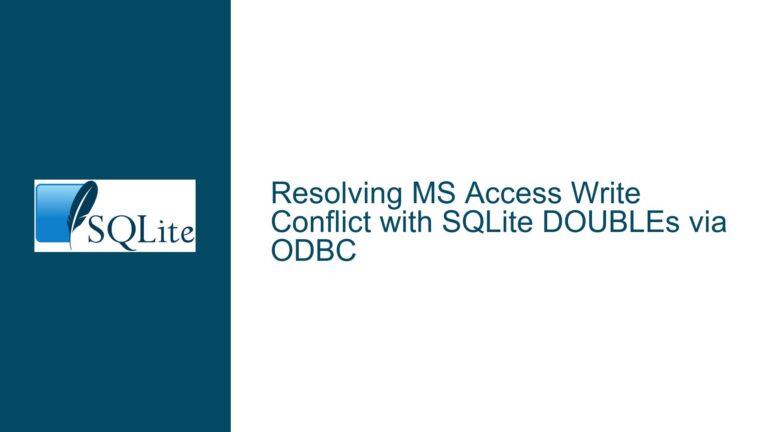SQLite WAL Policy, Undo/Redo Logging, and Transaction Management
Issue Overview: SQLite’s WAL Journal Mode and Transaction Durability Characteristics
The core issue revolves around understanding SQLite’s Write-Ahead Logging (WAL) journaling policy and its relationship to transaction durability mechanisms. A user raised questions about whether SQLite’s WAL mode implements "steal" and "force" policies with an undo log (rollback journal) and no redo log. This inquiry touches on three critical aspects of database engineering: (1) the behavior of transaction commits and rollbacks, (2) the role of journal files in crash recovery, and (3) how SQLite aligns with academic concepts like "steal/no-steal" and "force/no-force" policies.
SQLite supports multiple journal modes, including DELETE, TRUNCATE, PERSIST, MEMORY, and WAL. The WAL mode replaces the traditional rollback journal with a write-ahead log, fundamentally altering how transactions interact with the database file. The confusion arises from conflating the rollback journal (used in non-WAL modes) with the WAL file’s behavior. In non-WAL modes, the rollback journal acts as an undo log, allowing transactions to revert changes. In WAL mode, the database uses a write-ahead log to record changes before they reach the main database file, which introduces redo-like behavior.
The user’s hypothesis posits that SQLite uses a "steal" policy (allowing uncommitted changes to be written to the database) and a "force" policy (requiring all changes to be written to disk at commit time). This would imply no need for redo logs. However, SQLite’s implementation is nuanced. The WAL mode decouples transaction commits from direct writes to the main database file, enabling concurrent reads and writes. This design introduces a hybrid approach that doesn’t map cleanly to classic steal/no-steal or force/no-force taxonomies.
Possible Causes: Misinterpretations of WAL Mechanics and Recovery Protocols
Misunderstandings about SQLite’s WAL policy stem from four primary sources:
Ambiguity in Academic Terminology: Terms like "steal," "force," "undo," and "redo" originate from academic database literature and aren’t explicitly used in SQLite’s documentation. SQLite’s architecture implements similar concepts but with implementation-specific optimizations. For instance, the WAL file serves as both a redo log (for recovering committed transactions) and a mechanism for atomic commits.
Conflation of Rollback Journal and WAL File Roles: In non-WAL modes, the rollback journal stores undo information to revert incomplete transactions. In WAL mode, the WAL file records changes before they’re applied to the database, enabling redo operations during recovery. The original question incorrectly associates the rollback journal (an undo log) with WAL mode, which doesn’t use it.
Overlooking Checkpointing in WAL Mode: WAL mode defers writing changes to the main database file until a checkpoint occurs. This separation between transaction commit (writing to WAL) and checkpointing (applying WAL to the database) invalidates the "force" policy assumption, as committed changes reside in the WAL file rather than the main database.
Misapplying ACID Semantics to Journal Modes: SQLite guarantees atomicity and durability regardless of journal mode, but the mechanisms differ. WAL mode optimizes for concurrency by allowing readers to coexist with writers, whereas non-WAL modes use exclusive locks. This distinction affects how undo/redo operations are handled but doesn’t eliminate the need for recovery logs.
Troubleshooting Steps, Solutions & Fixes: Resolving WAL Policy Confusion
Step 1: Clarify SQLite’s Journal Modes and Their Implications
SQLite operates in one of five journal modes:
- DELETE: Default mode. Uses a rollback journal for undo operations.
- TRUNCATE: Similar to DELETE but truncates the journal file instead of deleting it.
- PERSIST: Zeroes the journal header instead of deleting the file.
- MEMORY: Stores the journal in RAM, sacrificing durability.
- WAL: Uses a write-ahead log for concurrency and performance.
In non-WAL modes, the rollback journal stores pre-modification database pages, enabling undo operations. When a transaction commits, SQLite "forces" these changes to disk by syncing the journal (if PRAGMA synchronous=FULL). This aligns with a "no-steal" policy (uncommitted changes aren’t written to the database) and "force" (committed changes are immediately written).
In WAL mode, changes are appended to the WAL file, and the database file remains unmodified until a checkpoint. This resembles a "steal" policy because uncommitted changes in the WAL aren’t immediately written to the database. However, the WAL itself acts as a redo log, ensuring durability without requiring immediate database writes.
Step 2: Map SQLite’s Behavior to Steal/Force Policies
Steal Policy: A database allows uncommitted changes to be written to the database (steal) or prohibits it (no-steal).
- Non-WAL modes: No-steal. The rollback journal holds changes until commit.
- WAL mode: Steal. Changes are written to the WAL file before commit, and the WAL may contain uncommitted changes.
Force Policy: A database requires all committed changes to be written to the database (force) or allows deferred writes (no-force).
- Non-WAL modes: Force. On commit, changes are written to the database file.
- WAL mode: No-force. Committed changes reside in the WAL until checkpointing.
Step 3: Analyze Undo and Redo Logging Mechanisms
Undo Logging: Used to roll back aborted transactions.
- Non-WAL modes: The rollback journal serves as an undo log.
- WAL mode: Undo information is stored in the WAL file’s "frames," but rollback uses the database’s page versioning.
Redo Logging: Used to reapply committed changes after a crash.
- Non-WAL modes: No explicit redo log. Durability is achieved by syncing the database file.
- WAL mode: The WAL file acts as a redo log. During recovery, uncheckpointed WAL entries are reapplied.
Step 4: Address the Original Hypothesis
The user speculated that SQLite uses "steal" and "force" policies with an undo log and no redo log. This is partially correct for non-WAL modes (no-steal, force, undo log) but incorrect for WAL mode. In WAL:
- Steal: Yes (uncommitted changes in WAL).
- Force: No (changes remain in WAL until checkpoint).
- Undo: Implemented via WAL versioning.
- Redo: Implemented via WAL replay.
Step 5: Configure and Verify Journal Modes
To resolve ambiguities, use these SQL commands:
PRAGMA journal_mode; -- Check current journal mode
PRAGMA journal_mode=WAL; -- Switch to WAL mode
PRAGMA wal_checkpoint; -- Manually trigger a checkpoint
Monitor the WAL file size and checkpoint behavior to observe how changes propagate from WAL to the database.
Step 6: Optimize WAL and Checkpoint Settings
- Adjust
PRAGMA wal_autocheckpointto control automatic checkpointing. - Use
PRAGMA synchronousto balance durability and performance. - In WAL mode, ensure the application handles long-running transactions to prevent WAL file bloat.
Step 7: Test Crash Recovery Scenarios
Simulate crashes during transactions to verify recovery behavior:
- Start a transaction, modify data, and kill the process.
- Restart the application and check data consistency.
- In WAL mode, confirm that the database rolls back uncommitted changes and reapplies committed ones from the WAL.
Step 8: Review SQLite Documentation on Atomic Commit
SQLite’s atomic commit mechanism (https://www.sqlite.org/atomiccommit.html) explains how journal files ensure transaction integrity. The WAL mode’s "commit then checkpoint" approach diverges from traditional force policies but maintains durability through the WAL file.
Step 9: Cross-Compare with Other Databases
Compare SQLite’s WAL with PostgreSQL’s WAL or MySQL’s InnoDB redo logs. While similar in concept, SQLite’s WAL is optimized for embedded use, avoiding background threads for checkpointing.
Final Resolution
SQLite’s WAL mode implements a "steal, no-force" policy with a hybrid undo/redo mechanism via the WAL file. The rollback journal is irrelevant in WAL mode, and recovery relies on reapplying WAL entries (redo) and versioning (undo). Understanding this clarifies how SQLite balances ACID compliance with performance in embedded environments.

